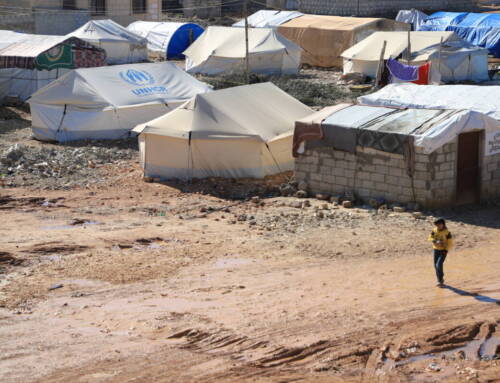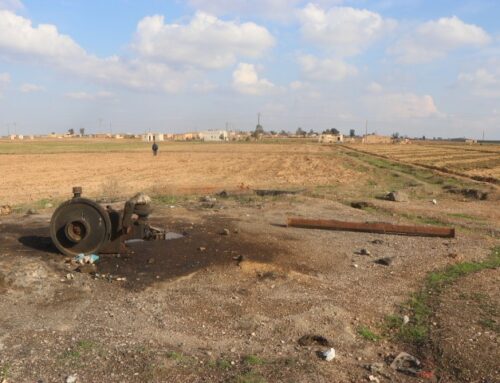From sovereignty to dependence: How Russia’s war threatens food security in Syria
The Russian invasion of Ukraine is already disrupting global supply chains of staple goods, notably cereals and cooking oils. This is likely to impact food security in Syria, which already suffers from shortages and skyrocketing inflation.
21 March 2022
PARIS — Eleven years after the start of a momentous revolution exacerbated by popular discontent about rising food prices, food insecurity has reached unprecedented highs in Syria. In January, the average price of the standard food basket provided by humanitarian organizations and designed to feed a family for a month reached a record high (SYP 225,398, $90 at the official exchange rate), marking an 86 percent increase over a single year.
Unfortunately, Syrians’ plight is in line with a global trend of rising hunger due to the growing cost of food. Last year, staple crops reached their highest global price in a decade: wheat prices increased by 38 percent and maize (corn) by 40 percent. Part of the increase was due to the COVID-19 pandemic, which disrupted supply chains, including fertilizer production and shipping costs. Drought in South America, a top exporter of corn and soybean, also led to a decline in the production of many staples.
Global hunger is expected to become even worse this year following Russia’s invasion of Ukraine. Together, Ukraine and Russia produce over 30 percent of wheat, 30 percent of barley, 20 percent of corn, and over 70 percent of sunflower oil globally, and much of this production may not reach international markets this year. Ukraine has already suspended wheat exports, saying it needs to prepare for the humanitarian fallout of the war. Russia likewise halted exports of ammonium nitrate—a key component of most fertilizers—of which it is the world’s top producer.
The Middle East is on the frontlines of the coming food crisis, experts monitoring agricultural markets warn. Wheat forms the basis of most diets in the region, which is among the top buyers of Ukrainian and Russian wheat. And local food production will likely suffer from global increases in fuel, pesticide and fertilizer prices.
So what does this mean for food security in Syria, where the agricultural sector has been devastated by a decade of war and 13 million people, more than half of the population, are already food insecure?
The looming impact of the Russian invasion of Ukraine differs between regime-held areas of Syria and the country’s northeast and northwest—three regions controlled by different entities and exposed to unique challenges regarding local crop production and the ability to import food.
Damascus and regime-controlled areas
Once a regional breadbasket producing more grain than it consumed, Syria has grown increasingly reliant on imported wheat since the start of the war. Dependence is particularly high in Damascus and regime-held areas, since 70 percent of Syria’s wheat fields are concentrated in the country’s northeast, beyond the control of Bashar al-Assad’s regime.
Wheat is the regime’s achilles heel. After extensively bombing bakeries, agricultural infrastructure, water stations, grain silos and farmland with the help of Russia, the Assad regime has gradually reclaimed control over scorched lands and people it can no longer feed.
[irp posts=”43274″ name=”Sowing fear, burning crops: The latest regime offensive terrorizes farmers in northwest Syria”]In recent years, long queues have become a characteristic sight in front of Damascus’ bakeries, despite the soaring price of bread. In February 2020, the government added bread to the “smart card” system, which allows families to access subsidized rations of basic goods, but there is simply not enough to meet demand. In January, hundreds of thousands of people were excluded from the subsidies system, which has become too costly for the state.
Shortages of flour have been aggravated by Western sanctions, including the Caesar sanctions that entered into force in May 2020 and forbid dealing with the Syrian government and blacklisted entities. Despite humanitarian and medical carve-outs, sanctions have effectively discouraged investments and exports, incentivized banks to stay clear of transactions involving Syria and driven the Syrian pound into the ground.
Given its pariah status on international markets and lack of currency, the regime has repeatedly relied on Russia as a provider of last resort. Damascus imported 675,000 tons of wheat from Russia in 2020 and another 400,000 tons in 2021. It should continue to rely on Russia’s huge fertilizer and grain production in 2022, but this will only be possible if the goods can transit through the Black Sea and across Turkey. For now, shipping lanes in the Black Sea have been deserted by ships, for fear of getting caught in the conflict.
Were the Russian supply line to dry up, Iran—Syria’s other long-standing ally and the region’s top wheat producer—is unlikely to step in. Iran’s wheat production is set to drop by 20 percent this year following a severe drought.
In parallel, the war on Ukraine seems to have pushed the Syrian currency further into the abyss: within 10 days of Russia’s invasion, it dropped by over seven percent relative to the US dollar, the sharpest drop in its value since September 2021.
The Syrian government already anticipates price hikes in oil, transportation and staple foods. Last week, the Council of Ministers announced it would ration basic goods like wheat, sugar and cooking oil, and restrict public spending in anticipation of higher import costs.
As usual, those who stand to suffer the most from the crisis are civilians, particularly those that are at odds with the regime. The Rukban camp, located in a “deconfliction zone” besieged by the Syrian army, is likely to be hit hard. No humanitarian convoy has reached the camp since September 2019, meaning the 10,000 residents are entirely reliant on a handful of smugglers bringing foodstuffs from black markets in regime-held areas. The price of wheat in Rukban is already inflated and flour shortages are chronic.
Northwestern Syria
The war in Ukraine risks exacerbating northwestern Syria’s dire humanitarian situation through two channels: the rising cost of aid and logistical challenges to providing it.
Opposition-held areas of northwestern Syria, which encompass most of Idlib and Aleppo provinces, rely heavily on aid brought from across the border with Turkey. The region is home to nearly 5 million people, including nearly 3 million internally displaced people, most of whom receive some form of food assistance.
The UN’s World Food Programme (WFP) supports nearly 6 million people in Syria, one third of whom are located in the northwest. It also buys more than half of its wheat from Ukraine and Russia, meaning that its operational costs will be directly impacted by the ongoing war.
Meanwhile, neighboring markets from which NGOs source much of the food aid they provide are becoming increasingly protectionary. Egypt, one of the region’s agricultural powerhouses, recently announced it would withhold exports of key staples including wheat, lentil and bean products for the coming three months. Algeria followed suit on March 14.
Most worryingly, Turkey is enmeshed in a currency crisis of its own and has started stockpiling staple goods to curb inflation. In the wake of the Russian invasion of Ukraine, Turkey extended a list of key exports to be restricted at the discretion of the Ministry of Agriculture. Ankara also banned the export of cooking oils, leading to a price spike in northwestern Syrian markets. Since the restrictions were enacted, some humanitarian shipments to Syria have remained stuck at the border.
Mounting tensions between Russia and the West also jeopardize the renewal of the UN cross-border aid mechanism. Legally, the UN’s ability to pass goods, staff and funds into Syria from Turkey is based on a yearly UN Security Council resolution that overrides the need for Syrian government authorization to cross into the country. The latest resolution expires on July 10. So far, states have always managed to renew the resolution in extremis despite Russian threats to block it using its veto power. But this year, negotiations could be more complicated than ever before, especially if Russia tries to leverage its veto power on Syria to extract concessions from Western states regarding Ukraine.
Non-renewal of the UN resolution would mean that the UN could no longer facilitate the passage of aid at the Bab al-Hawa border crossing, leaving NGOs to figure out how to bring hundreds of trucks filled with aid across the border by themselves. Cross-border funding would also abruptly end. Some of it could be redirected through international and local NGOs, but these actors do not enjoy the same level of financial trust from state donors, nor do they have the capacity to replace the existing–and massive—UN machine currently in place.
[irp posts=”42046″ name=”Lessons from al-Yaroubiah: Can cross-line aid replace the UN cross-border mechanism in northwest Syria?”]Northeastern Syria
Syria’s northeastern Hasakah, Raqqa and Deir e-Zor provinces grow around 80 percent of Syria’s wheat and barley and should be less affected by the war in Ukraine, but they remain highly vulnerable. Flour shortages have already been reported in several bakeries, prompting local authorities to allow them to sell bread made from a mix of wheat and corn flour.
The region is still reeling from extreme drought last year, which devastated rain-fed wheat-growing areas in northeastern Syria and neighboring Iraq. The drought stood out as “one of the worst” in Syria’s recent history, the Global Drought Observatory, a global monitoring service, warned in April 2021. That year, the harvest fell by more than 60 percent compared to 2020.
Northeastern Syria’s wheat is planted in winter and harvested in June or July, so the outlook for 2022 is still unclear. If crops fail like last year, local authorities will have to compensate for lower production through higher imports, and become more vulnerable to the impact of the Ukraine war. Disruptions in global fertilizer production will also impact local livelihoods, since 70 percent of the population depend on the agricultural sector for a living and farmers are already struggling to manage the rising cost of fuel, seeds and inputs.
Still, the Kurdish-led Autonomous Administration (AANES) controlling northeastern Syria is better positioned than Damascus to deal with the coming crisis, since it was recently exempted from Caesar sanctions, giving it more access to international markets.
Towards resilience?
Looking at the impact of war in Ukraine, it is clear that every region in Syria has become more vulnerable to external shocks and global market disruptions. Syria has moved from a situation of relative sufficiency in the 1990s to one of complete dependency today.
This is the result of a decade of war, and specifically of the unlawful and systematic targeting of food systems, among other violations of international law. To this day, various parties to the conflict, chief among them the Assad regime and Russia, continue to undermine Syria’s food security by bombing water stations and burning fields and orchards.
Syria’s current dependence on aid will do little to help rebuild the country’s food sovereignty. Much humanitarian funding is directed towards fixing “emergencies” that have effectively become permanent after a decade of war, mirroring the plight of millions of displaced people in northwest Syria who continue to live in “temporary” tents, ten years on.
Recently, donors and NGOs have shifted to new buzzwords, such as “resilience” and “livelihoods,” saying they will direct more thought and funding to building local resources and know-how. Only time will tell if this is truly a meaningful change of approach. The war in Ukraine has demonstrated that such a shift is urgently needed.







